Laser-Induced Chirality of Plasmonic Nanoparticles Embedded in Porous Matrix
Abstract
1. Introduction
2. Materials and Methods
2.1. Chemicals
2.2. Synthesis of Gold NPs
2.3. Incorporation of Gold NPs into NPSM
2.4. Laser Modification of Gold NPs in the Porous Matrix
2.5. Characterization
3. Results and Discussion
4. Conclusions
Author Contributions
Funding
Data Availability Statement
Acknowledgments
Conflicts of Interest
Abbreviations
| CD | Circular dichroism |
| NPs | Nanoparticles |
| NPSM | Nanoporous silicate matrix |
| RHCL | Right-handed circular polarization |
| CPL | Circular polarized luminescence |
Appendix A
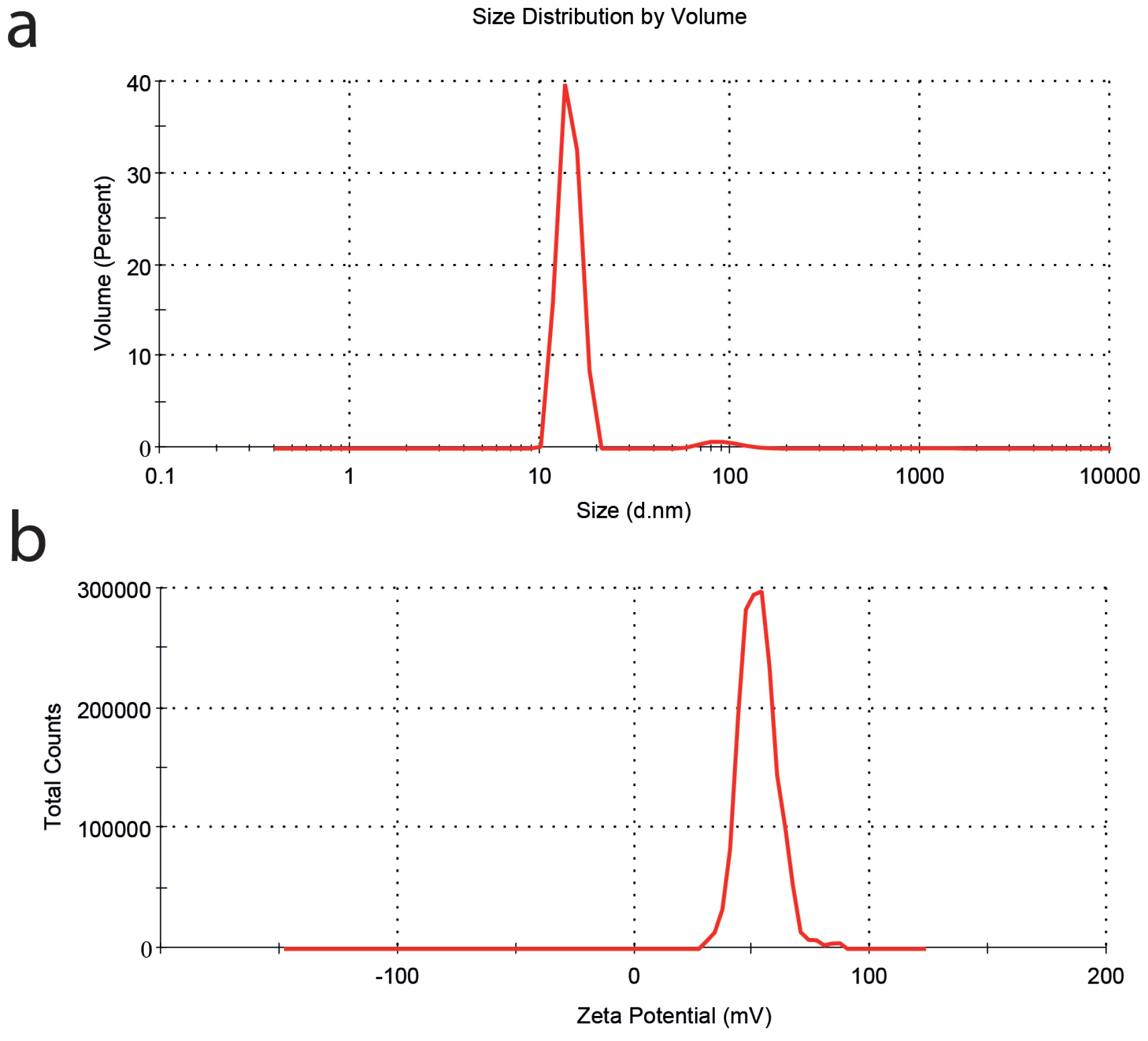

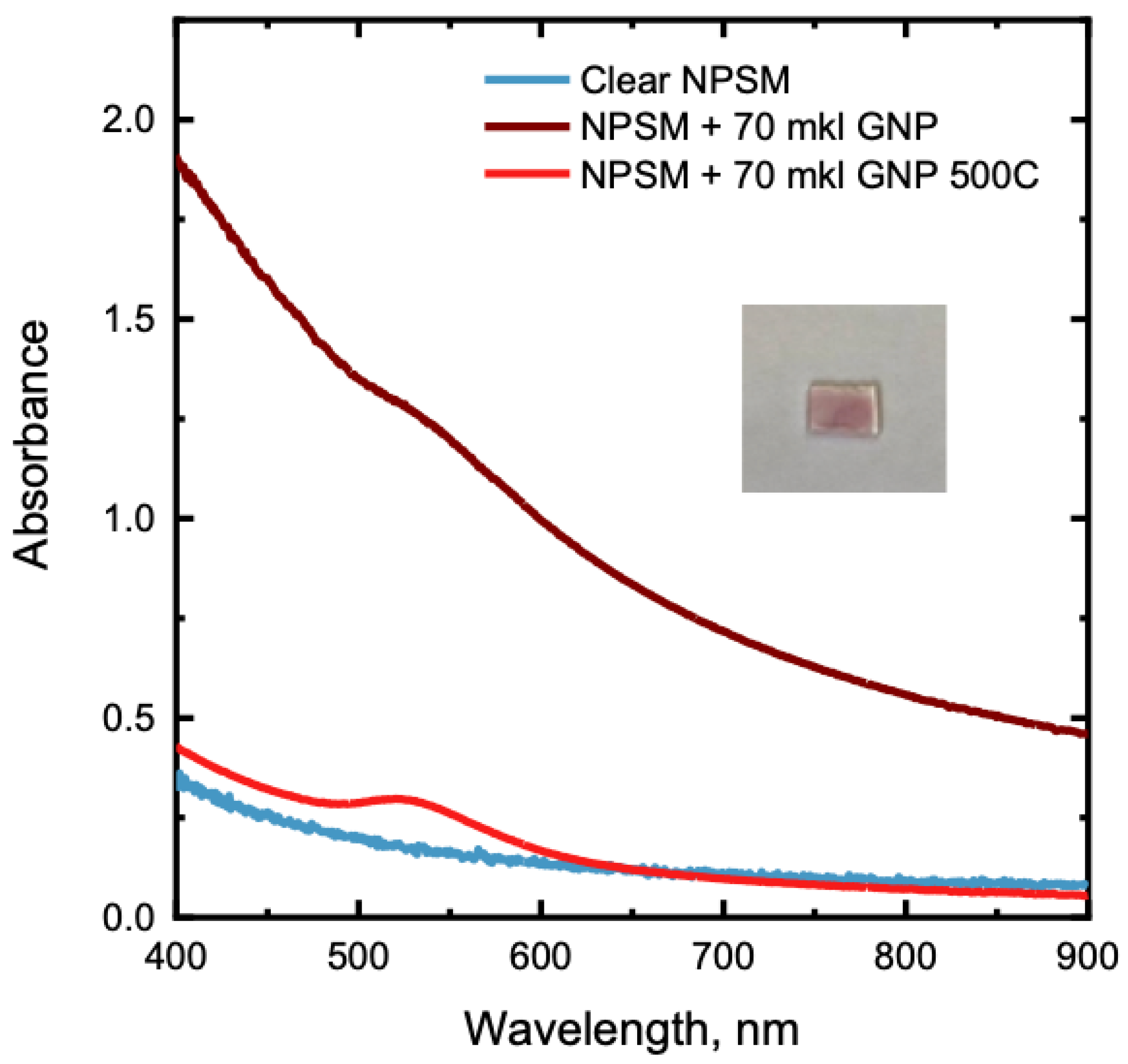
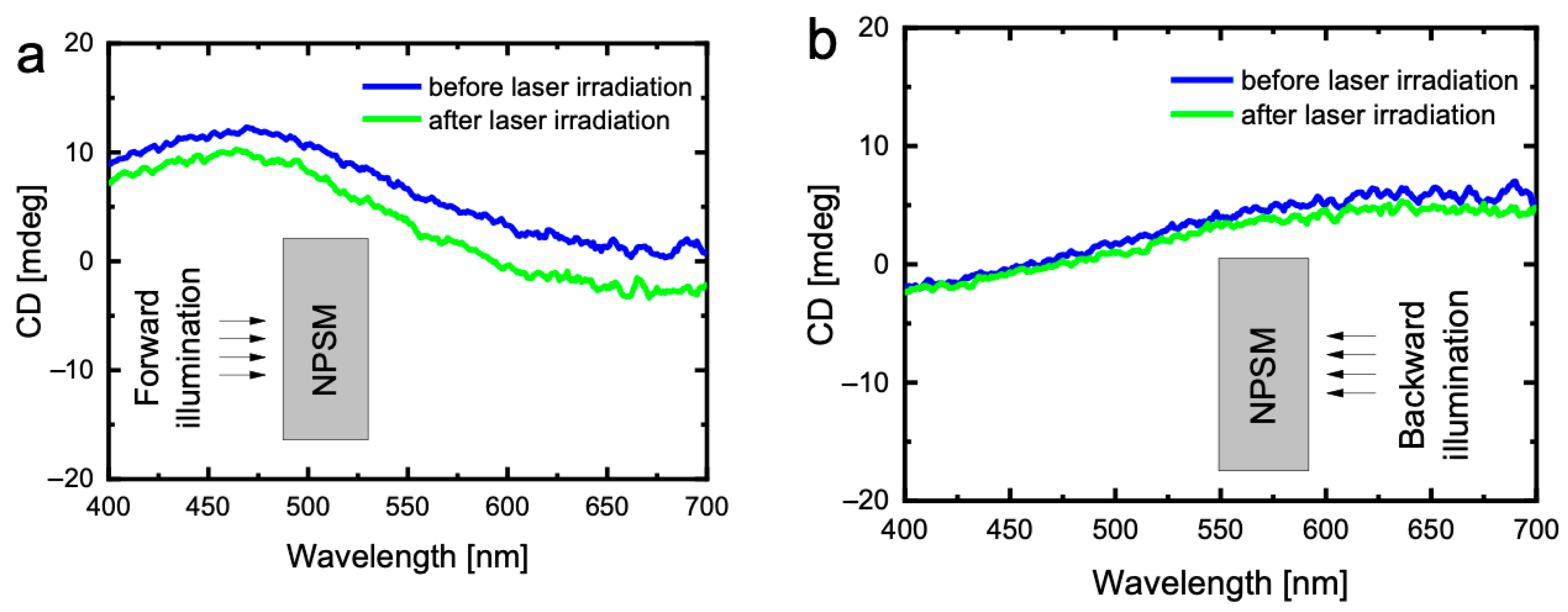
References
- Yang, Y.; Kim, Y.; Gwak, J.; So, S.; Mun, J.; Kim, M.; Jeong, H.; Kim, I.; Badloe, T.; Rho, J. Realization of Artificial Chirality in Micro-/Nano-Scale Three-Dimensional Plasmonic Structures. In Chirality, Magnetism and Magnetoelectricity; Springer: Cham, Switzerland, 2021; pp. 241–263. [Google Scholar] [CrossRef]
- Banik, S.D.; Nandi, N. Chirality and protein biosynthesis. Top. Curr. Chem. 2013, 333, 23019095. [Google Scholar] [CrossRef]
- Zheng, Y.; Mao, K.; Chen, S.; Zhu, H. Chirality Effects in Peptide Assembly Structures. Front. Bioeng. Biotechnol. 2021, 9, 703004. [Google Scholar] [CrossRef] [PubMed]
- Pu, F.; Ren, J.; Qu, X. Nucleobases, nucleosides, and nucleotides: Versatile biomolecules for generating functional nanomaterials. Chem. Soc. Rev. 2018, 47, 1285–1306. [Google Scholar] [CrossRef]
- Winogradoff, D.; Li, P.Y.; Joshi, H.; Quednau, L.; Maffeo, C.; Aksimentiev, A. Chiral Systems Made from DNA. Adv. Sci. 2021, 8, 2003113. [Google Scholar] [CrossRef] [PubMed]
- Fernández-García, J.; Evans, P.J.; Filippone, S.; Herranz, M.Á.; Martín, N. Chiral Molecular Carbon Nanostructures. Acc. Chem. Res. 2019, 52, 1565–1574. [Google Scholar] [CrossRef] [PubMed]
- Yang, F.; Wang, M.; Zhang, D.; Yang, J.; Zheng, M.; Li, Y. Chirality Pure Carbon Nanotubes: Growth, Sorting, and Characterization. Chem. Rev. 2020, 120, 2693–2758. [Google Scholar] [CrossRef]
- Gao, X.; Han, B.; Yang, X.; Tang, Z. Perspective of Chiral Colloidal Semiconductor Nanocrystals: Opportunity and Challenge. J. Am. Chem. Soc. 2019, 141, 13700–13707. [Google Scholar] [CrossRef]
- Wu, W.; Pauly, M. Chiral plasmonic nanostructures: Recent advances in their synthesis and applications. Mater. Adv. 2022, 3, 186–215. [Google Scholar] [CrossRef]
- Warning, L.A.; Miandashti, A.R.; McCarthy, L.A.; Zhang, Q.; Landes, C.F.; Link, S. Nanophotonic Approaches for Chirality Sensing. ACS Nano 2021, 15, 15538–15566. [Google Scholar] [CrossRef]
- Zor, E.; Bingol, H.; Ersoz, M. Chiral sensors. TrAC Trends Anal. Chem. 2019, 121, 115662. [Google Scholar] [CrossRef]
- Gogoi, A.; Mazumder, N.; Konwer, S.; Ranawat, H.; Chen, N.T.; Zhuo, G.Y. Enantiomeric Recognition and Separation by Chiral Nanoparticles. Molecules 2019, 24, 1007. [Google Scholar] [CrossRef] [PubMed]
- Mao, X.; Li, H. Chiral imaging in living cells with functionalized graphene oxide. J. Mater. Chem. B 2013, 1, 4267–4272. [Google Scholar] [CrossRef] [PubMed]
- Li, Y.; Zhou, Y.; Wang, H.Y.; Perrett, S.; Zhao, Y.; Tang, Z.; Nie, G. Chirality of Glutathione Surface Coating Affects the Cytotoxicity of Quantum Dots. Angew. Chem. Int. Ed. 2011, 50, 5860–5864. [Google Scholar] [CrossRef] [PubMed]
- Yasukawa, T.; Kobayashi, S. Chiral Metal Nanoparticles for Asymmetric Catalysis. In Nanoparticles in Catalysis; Springer: Cham, Switzerland, 2020; pp. 279–314. [Google Scholar] [CrossRef]
- Jiang, S.; Kotov, N.A. Circular Polarized Light Emission in Chiral Inorganic Nanomaterials. Adv. Mater. 2022, 2022, 2108431. [Google Scholar] [CrossRef] [PubMed]
- Han, X.; Liu, K.; Sun, C. Plasmonics for Biosensing. Materials 2019, 12, 1411. [Google Scholar] [CrossRef] [PubMed]
- Bochenkov, V.E.; Sutherland, D.S. Chiral plasmonic nanocrescents: Large-area fabrication and optical properties. Opt. Express 2018, 26, 27101–27108. [Google Scholar] [CrossRef]
- Klös, G.; Andersen, A.; Miola, M.; Birkedal, H.; Sutherland, D.S. Oxidation controlled lift-off of 3D chiral plasmonic Au nano-hooks. Nano Res. 2019, 12, 1635–1642. [Google Scholar] [CrossRef]
- Manoccio, M.; Esposito, M.; Passaseo, A.; Cuscunà, M.; Tasco, V. Focused Ion Beam Processing for 3D Chiral Photonics Nanostructures. Micromachines 2020, 12, 6. [Google Scholar] [CrossRef]
- Kuzyk, A.; Schreiber, R.; Fan, Z.; Pardatscher, G.; Roller, E.M.; Högele, A.; Simmel, F.C.; Govorov, A.O.; Liedl, T. DNA-based self-assembly of chiral plasmonic nanostructures with tailored optical response. Nature 2012, 483, 311–314. [Google Scholar] [CrossRef]
- Sakellari, I.; Yin, X.; Nesterov, M.L.; Terzaki, K.; Xomalis, A.; Farsari, M. 3D Chiral Plasmonic Metamaterials Fabricated by Direct Laser Writing: The Twisted Omega Particle. Adv. Opt. Mater. 2017, 5, 1700200. [Google Scholar] [CrossRef]
- Syubaev, S.; Zhizhchenko, A.; Kuchmizhak, A.; Porfirev, A.; Pustovalov, E.; Vitrik, O.; Kulchin, Y.; Khonina, S.; Kudryashov, S. Direct laser printing of chiral plasmonic nanojets by vortex beams. Opt. Express 2017, 25, 10214–10223. [Google Scholar] [CrossRef] [PubMed]
- Vartanyan, T.; Bosbach, J.; Stietz, F.; Träger, F. Theory of spectral hole burning for the study of ultrafast electron dynamics in metal nanoparticles. Appl. Phys. B 2001, 73, 391–399. [Google Scholar] [CrossRef]
- Hubenthal, F.; Hendrich, C.; Träger, F. Damping of the localized surface plasmon polariton resonance of gold nanoparticles. Appl. Phys. B 2010, 100, 225–230. [Google Scholar] [CrossRef]
- DeSantis, C.J.; Huang, D.; Zhang, H.; Hogan, N.J.; Zhao, H.; Zhang, Y.; Manjavacas, A.; Zhang, Y.; Chang, W.S.; Nordlander, P.; et al. Laser-Induced Spectral Hole-Burning through a Broadband Distribution of Au Nanorods. J. Phys. Chem. C 2016, 120, 20518–20524. [Google Scholar] [CrossRef]
- Wang, Z.; Kan, Z.; Shen, M. Study the plasmonic property of gold nanorods highly above damage threshold via single-pulse spectral hole-burning experiments. Sci. Rep. 2021, 11, 22232. [Google Scholar] [CrossRef]
- Toropov, N.A.; Leonov, N.B.; Vartanyan, T.A. Influence of Silver Nanoparticles Crystallinity on Localized Surface Plasmons Dephasing Times. Phys. Status Solidi B 2018, 255, 1700174. [Google Scholar] [CrossRef]
- Toropov, N.A.; Gladskikh, I.A.; Parfenov, P.S.; Vartanyan, T.A. Fabrication and laser-assisted modification of the Ag particles ensembles supporting quadrupole plasmon oscillations. Opt. Quantum Electron. 2017, 49, 1–8. [Google Scholar] [CrossRef]
- Sau, T.K.; Murphy, C.J. Room Temperature, High-Yield Synthesis of Multiple Shapes of Gold Nanoparticles in Aqueous Solution. J. Am. Chem. Soc. 2004, 126, 8648–8649. [Google Scholar] [CrossRef]
- Andreeva, O.V.; Obyknovennaya, I.E.; Gavrilyuk, E.R.; Paramonov, A.A.; Kushnarenko, A.P. Silver-halide photographic materials based on nanoporous glasses. J. Opt. Technol. JOT 2005, 72, 916–922. [Google Scholar] [CrossRef]
- Bykov, E.P.; Zakoldaev, R.A.; Andreeva, N.V.; Shishkina, A.S.; Yandybaeva, Y.I.; Andreeva, O.V. Production of nanoporous silicate matrices—problems of optical homogeneity. J. Opt. Technol. JOT 2022, 89, 161–168. [Google Scholar] [CrossRef]
- Romashkina, A.M.; Novikov, V.B.; Murzina, T.V. Collective lattice and plasmonic resonances in the enhancement of circular dichroism in disk–rod metasurface. J. Appl. Phys. 2023, 133, 043103. [Google Scholar] [CrossRef]
- Liu, S.D.; Liu, J.Y.; Cao, Z.; Fan, J.L.; Lei, D. Dynamic tuning of enhanced intrinsic circular dichroism in plasmonic stereo-metamolecule array with surface lattice resonance. Nanophotonics 2020, 9, 3419–3434. [Google Scholar] [CrossRef]

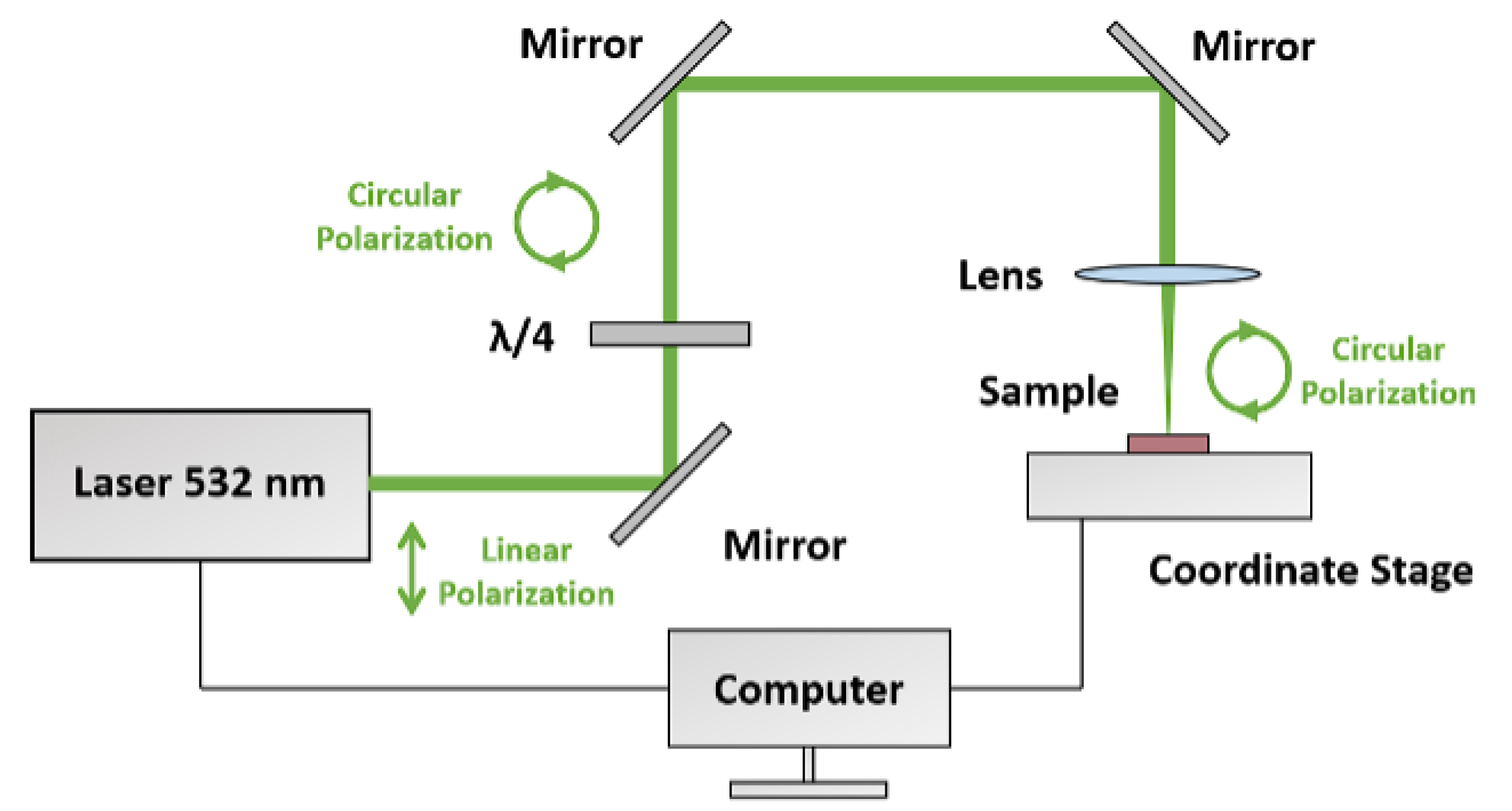
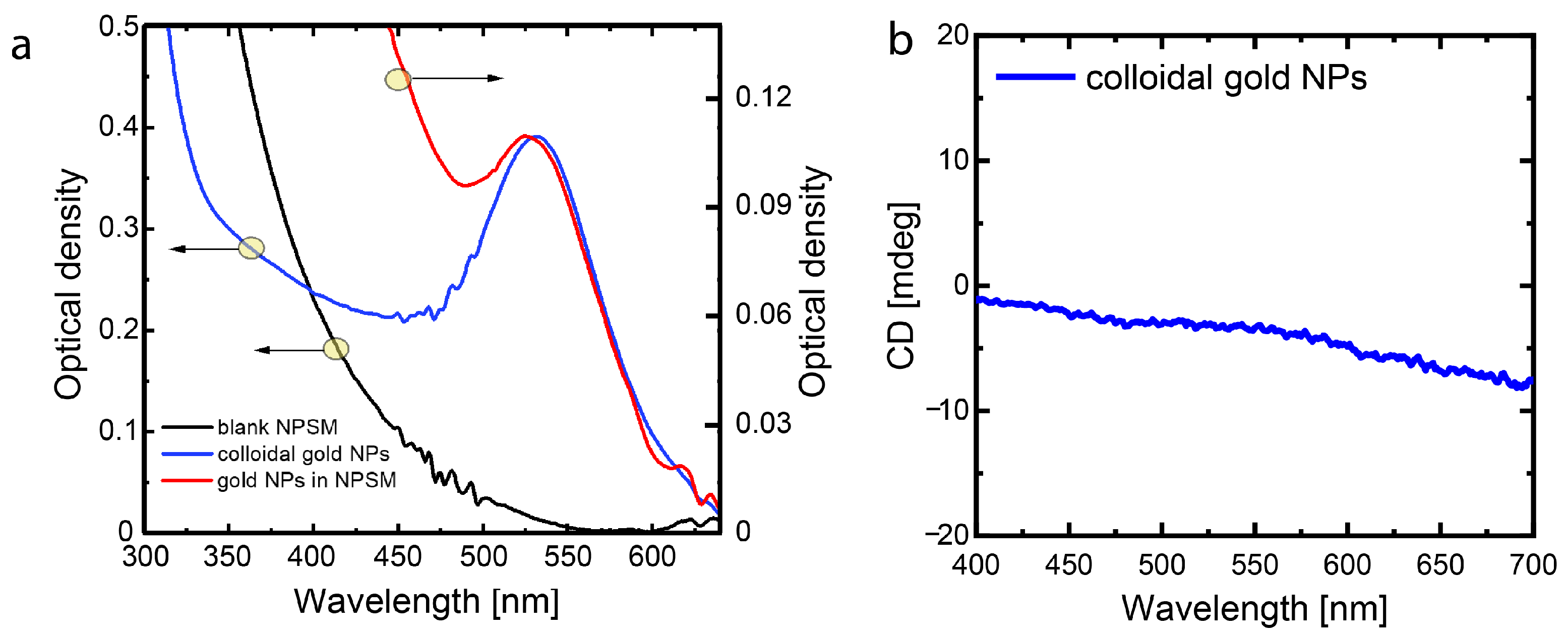

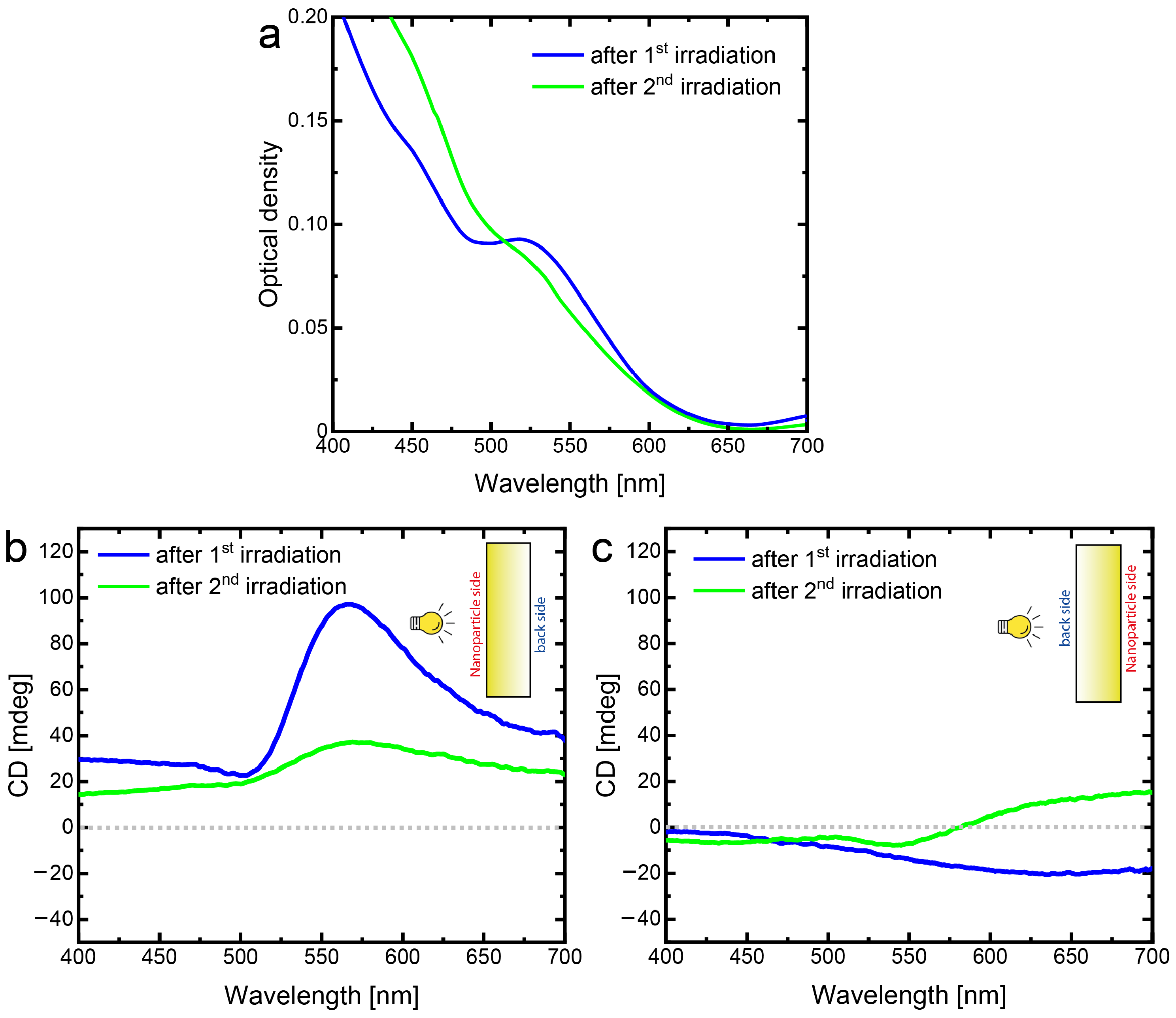
Disclaimer/Publisher’s Note: The statements, opinions and data contained in all publications are solely those of the individual author(s) and contributor(s) and not of MDPI and/or the editor(s). MDPI and/or the editor(s) disclaim responsibility for any injury to people or property resulting from any ideas, methods, instructions or products referred to in the content. |
© 2023 by the authors. Licensee MDPI, Basel, Switzerland. This article is an open access article distributed under the terms and conditions of the Creative Commons Attribution (CC BY) license (https://creativecommons.org/licenses/by/4.0/).
Share and Cite
Sapunova, A.A.; Yandybaeva, Y.I.; Zakoldaev, R.A.; Afanasjeva, A.V.; Andreeva, O.V.; Gladskikh, I.A.; Vartanyan, T.A.; Dadadzhanov, D.R. Laser-Induced Chirality of Plasmonic Nanoparticles Embedded in Porous Matrix. Nanomaterials 2023, 13, 1634. https://doi.org/10.3390/nano13101634
Sapunova AA, Yandybaeva YI, Zakoldaev RA, Afanasjeva AV, Andreeva OV, Gladskikh IA, Vartanyan TA, Dadadzhanov DR. Laser-Induced Chirality of Plasmonic Nanoparticles Embedded in Porous Matrix. Nanomaterials. 2023; 13(10):1634. https://doi.org/10.3390/nano13101634
Chicago/Turabian StyleSapunova, Anastasiia A., Yulia I. Yandybaeva, Roman A. Zakoldaev, Alexandra V. Afanasjeva, Olga V. Andreeva, Igor A. Gladskikh, Tigran A. Vartanyan, and Daler R. Dadadzhanov. 2023. "Laser-Induced Chirality of Plasmonic Nanoparticles Embedded in Porous Matrix" Nanomaterials 13, no. 10: 1634. https://doi.org/10.3390/nano13101634
APA StyleSapunova, A. A., Yandybaeva, Y. I., Zakoldaev, R. A., Afanasjeva, A. V., Andreeva, O. V., Gladskikh, I. A., Vartanyan, T. A., & Dadadzhanov, D. R. (2023). Laser-Induced Chirality of Plasmonic Nanoparticles Embedded in Porous Matrix. Nanomaterials, 13(10), 1634. https://doi.org/10.3390/nano13101634







